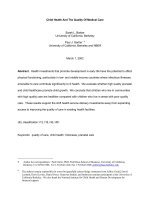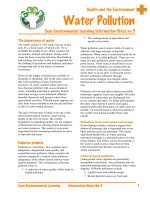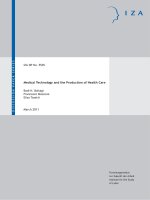Chasing molecules poisonous products human health and the promise of green chemistry
Bạn đang xem bản rút gọn của tài liệu. Xem và tải ngay bản đầy đủ của tài liệu tại đây (1.13 MB, 277 trang )
CHASING MOLECULES
CHASING MOLECULES
Poisonous Products, Human Health, and the
Promise of Green Chemistry
Elizabeth Grossman
/ Shearwater Books
Washington | Covelo | London
A Shearwater Book
Published by Island Press
Copyright © 2009 Elizabeth Grossman
All rights reserved under International and Pan-American Copyright Conventions. No part of this
book may be reproduced in any form or by any means without permission in writing from the publisher: Island Press, 1718 Connecticut Ave., NW, Suite 300, Washington, DC 20009.
SHEARWATER BOOKS is a trademark of The Center for Resource Economics.
Library of Congress Cataloging-in-Publication data.
Grossman, Elizabeth, 1957–
Chasing molecules : poisonous products, human health, and the promise of green
chemistry / Elizabeth Grossman.
p. cm.
“A Shearwater Book.”
Includes bibliographical references and index.
ISBN-13: 978-1-59726-370-2 (cloth : alk. paper)
ISBN-10: 1-59726-370-2 (cloth : alk. paper) 1. Environmental
toxicology—Popular works. 2. Environmental chemistry—Industrial
applications—Popular works. 3. Consumer goods—Toxicology—Popular works. I.
Title.
RA1226.G76 2010
615.9′02—dc22
2009028279
British Cataloguing-in-Publication data available.
The paperback edition carries the ISBN-13: 978-1-61091-161-0 and the ISBN-10: 1-61091-161-X
Printed on recycled, acid-free paper
Manufactured in the United States of America
10 9 8 7 6 5 4 3 2 1
For Jane and Olivia, with love and hope
In virtually every aspect in society, it has long been
acknowledged that preventing a problem is superior to
trying to solve it once it has been created.
—Paul Anastas and John Warner, 2000
Contents
Preface xiii
Prologue xvii
Chapter 1
There’s Something in the Air 1
Chapter 2
Swimmers, Hoppers, and Fliers 19
Chapter 3
Laboratory Curiosities and Chemical Unknowns 41
Chapter 4
The Polycarbonate Problem 55
Chapter 5
Plasticizers 83
Health Risks or Fifty Years of Denial of Data?
Chapter 6
The Persistent and Pernicious 99
Chapter 7
Out of the Frying Pan 123
Chapter 8
Nanotechnology 143
Perils and Promise of the Infinitesimal
Chapter 9
Material Consequences 159
Toward a Greening of Chemistry
Epilogue: Redesigning the Future 191
Acknowledgments 201
Appendix: Principles of Green Chemistry and Molecular
Design Pyramid Questions 203
Notes 205
Select Bibliography 229
Index 241
xi
Preface to Paperback Edition
Since Chasing Molecules was first published in the fall of 2009, synthetic
chemicals have been very much in the news. And for good reason. Almost
every week, if not daily, new scientific studies are published documenting
the adverse health effects of some chemicals that most of us encounter
daily. Consequently, once-obscure substances like bisphenol A and phthalates have become household names and it’s now becoming common
knowledge that many materials once thought to be biologically inert are
in fact mobile and active. As we learn more about how tiny amounts of
these chemicals—particularly those known as endocrine disrupters—can
interfere with the innermost workings of living cells, it becomes increasingly obvious that preventing such exposures is essential to protecting human health. Since 2009, the American Medical Association and scientific
societies representing more than 40,000 scientists worldwide have endorsed policies that call for reducing these exposures, especially for infants and children.
In response to the growing public concern, governments from China
to Chicago have enacted new laws regulating chemicals with known
health hazards—particularly in products used by infants and children.
Since the fall of 2009, legislators have held dozens of hearings in US state
xiii
xiv
Preface to the Paperback Edition
capitols and in Washington, DC to debate policies aimed at preventing
harmful chemical exposures. Many of the recent restrictions call for safe
alternatives. Many specifically mention green chemistry, which advocates
pollution prevention and the design of environmentally benign, resourceefficient materials.
Health concerns have also pushed manufacturers and retailers worldwide to seek out and offer products made with safer materials. Again,
thus far these changes focus on baby and children’s products. But manufacturers have also redesigned some electronics, cosmetics, cleaning and
personal care products, among others, to eliminate potentially hazardous
substances. In many cases, the market is shifting much faster than and
well in advance of regulation.
At the same time, recent disasters like the BP/Deepwater Horizon oil
spill and the nuclear power plant crisis brought on by the earthquake and
tsunami in Japan underscore the most fundamental principle of green
chemistry: that the best way to prevent toxic pollution is to eliminate hazards at the design stage rather than trying to contain contamination once
it’s entered the environment.
Unfortunately, following this principle has not been the norm. Not
only have we relied on minimizing and mitigating risk and hazardous
chemical exposures, but we know very little—if anything—about the toxicity of many of the tens of thousands of chemicals currently in use, or
the hundreds of new chemicals being invented every day. But the more
we learn about how chemicals behave, the clearer it becomes that regulating known toxics is not sufficient. To solve this problem proactively, we
need to bring chemical safety assessments up to date with current science—especially recent discoveries in molecular biology, endocrinology,
and genetics. We will need to design products whose environmental profile, manufacturing process, and ultimate performance are equally stellar—and to approach these solutions holistically.
With the safety of an ever-greater number of chemicals in question,
it’s evident that we need to solve this problem in a way that reflects our
expanding understanding of biology and accommodates our desire for
materials whose performance requires the manipulation of molecules.
Preface to the Paperback Edition
xv
This demands some unprecedented collaborations—between synthetic
chemists (the people who design new molecules) and environmental
health scientists (the people who investigate how environmental contaminants affect living cells and organisms). It also demands radical changes
in the design process—particularly, a willingness to reassess and redesign
an existing product when new hazards are identified.
Some of this work is now underway. In November 2008, leaders in
green chemistry and environmental health science met formally and publically for the first time in a symposium at the University of California
Irvine. The conference was organized by Advancing Green Chemistry
and Environmental Health Sciences, two non-profits working to foster
these cross-disciplinary efforts. Since then, a number of participating scientists have begun collaborating on projects aimed at producing safe new
materials and developing more effective ways of assessing endocrine disrupting and other potentially harmful chemicals.
Also central to these efforts is green chemistry education. It seems like
simple common sense that all chemistry students would learn what characteristics make a molecule safe or toxic, but this has not been part of a
traditional scientific education. While environmental health, ecology,
and toxicology have yet to be incorporated into American chemistry degree requirements, green chemistry courses are springing up around the
country as they are elsewhere around the world. That scientists from the
fields of chemistry and biology are working together to make sure that
a new plastic or cleaning agent will not adversely impact healthy cells is
revolutionary.
Talk of endocrine disrupters, genetics, and molecular design can
sound very abstract. Yet the topics explored in Chasing Molecules are intensely personal. During my travels in the eighteen months since the
book was first published, I have met people from all over the world who
are deeply concerned about how chemicals they encounter at home, at
work, or in the outdoor environment may affect their health and that of
their children. In June 2010, I met fishermen on the Gulf Coast who were
distraught that petrochemicals might be harming their immediate health
and contaminating the seafood they rely on for income and to feed their
xvi
Preface to the Paperback Edition
families. In October 2010, I met electronics industry workers from China,
Indonesia, Korea, the Philippines, and Taiwan—all had colleagues
stricken with illnesses associated with chemicals used in their factories.
Across the U.S., I’ve met dozens of people who peppered me with questions about which products are safe—for their children’s pajamas, a
teenager’s cosmetics, their home or office renovation, or to use in their
kitchen. A pediatric nurse wondered if the prevalence of metabolic and
neurological problems in her patients may be influenced by chemicals
children were exposed to early in life; a scientist confessed he had wondered for twenty years if chemicals he used in the lab may have caused
the birth defect that one of his children did not survive.
These concerns can easily be overwhelming, but what I’ve learned
convinces me that the problem of toxic chemicals, while enormously
challenging, can be solved. As Paul Anastas, one of the founders of green
chemistry, has said, “The reason to understand a problem is to empower
its solution.” Since the fall of 2009, we’ve learned a great deal more about
the problems caused by many of the synthetic chemicals that now permeate our lives. Policy, both public and corporate, has begun to respond in
substantive ways—as has consumer demand for safe alternatives.
We’ve made a start, but these efforts have only begun to scratch the
surface of what needs to change. Unfortunately, what’s happened during
this time economically, politically, and environmentally has whittled away
at our existing margins for resilience. We no longer have resources to
squander. To arrive at the point where assuring ourselves of product
safety does not require puzzling over mysterious ingredient lists or consulting massive databases, we will need to think broadly, creatively, and
systemically rather than piecemeal about new materials design. This is
about taking what we’ve learned about the extraordinary biological engineering of cells and natural systems and using that knowledge to design a
new generation of materials that are—to borrow a phrase from Amy
Cannon and John Warner—beyond benign.
Prologue
It is late September 2008 and I’m standing in the lobby of a Manila hotel
where I’m attending a meeting about occupational health, safety, and environmental issues for workers throughout Asia. On a television screen
nearby, polar bears are diving off a small ice floe. Later in the day, I visit
the National Museum of the Philippines where we tour an exhibit of
prize winners in a 2007 Filipino art competition. One of the paintings
shows a woman clad in a dress constructed of images of cars and smokestacks. She has her hands over her eyes in a gesture of despair and is up to
her hips in water. In this tropical island nation, merely 15 degrees north
of the equator, where many people live on the water’s edge, disappearing
polar bear habitat—a sign of global warming and harbinger of rising sea
levels—has local relevance. Over the next several days I meet people who
work in factories that make clothing, electronics, machinery, and other
products. When asked to name their top concerns about their working
conditions, leading the list are the impacts of chemicals to reproductive
health and the health of future generations. When asked what they
would do to improve workplace safety, all say, “Remove the chemical hazard. Substitute something safer.”
xvii
xviii
Prologue
This is, in essence, the story this book explores. Over the past century
our reliance on petroleum and coal has made available a vast quantity of
hydrocarbons. These byproducts of fuel refining have become the foundation for the overwhelming majority of our synthetic materials—manufactured substances that go into everything from computers to cosmetics.
We’ve managed to create tens of thousands of such new materials—
substances that exist nowhere in nature—and these materials now permeate every aspect of our lives. They have made possible the creation of
countless useful and often ingenious products: the lightweight, shatterproof, flame-resistant plastics used in electronics, aircraft, sports gear, and
motor vehicles; waterproof coatings for textiles; flexible plastics that go
into medical tubing and children’s toys; nonstick surfaces for food packaging; thin films that enable microchip etching; and polymers delicate
enough to coat an eyelash, to name but a few. It’s hard to imagine life
without them. These materials were designed to make life easier, more
efficient, more convenient and, in many cases, safer. And many do.
But many of these substances also behave in ways that make them
hazardous to human health and the environment. A number of these synthetic chemicals, scientists are discovering, are capable of interfering with
the biological mechanisms that determine the health of any living organism. These materials, it turns out, have been changing the world’s chemistry, in some instances altering the most fundamental building blocks of
life on Earth. As a result, the entire chemistry of the planet—from the cellular level to entire ecosystems—is now different than at any other time in
history.
This story is a sobering one. Yet what I learned while working on this
book—and even more, the people I met—inspire me to think that the
problems created by our past century’s choice of materials are not insoluble. As with climate change, it’s not possible to turn back the clock and
erase all of the damage caused. However, if we build on the efforts now
underway to create alternative materials that are safe for human health
and the environment, and if we can prevent further pollution by existing
harmful substances, great improvement and much recovery are possible.
Where toxic contaminants have been taken out of use—through volun-
Prologue
xix
tary efforts or more often when regulations are established and enforced—affected populations and individuals, if sufficiently healthy and
resilient, can and often do recover. But we have to act swiftly. As Paul
Anastas, director of the Center for Green Chemistry and Green Engineering at Yale University and a founder of the green chemistry movement
has said succinctly, “We don’t have a decade to blow.”1
Since the 1950s, if not earlier, scientists have been aware of the acute
adverse incidental impacts of numerous petroleum-based synthetic pesticides and industrial chemicals—immediate severe reactions in some cases
(to the respiratory or nervous system, for example), severe disorders such
as cancer or birth defects in others. In the past several decades, however,
our knowledge of how these substances make their way into the environment and our bodies, and how these widely used synthetic chemicals can
affect healthy living cells, has grown remarkably. We now know that such
chemicals are migrating not only from industrial and waste sites but also
from finished products designed for everyday use, products that range
from furniture and textiles to electronics, toys, and personal care products. Many of these substances are mobile, made up of molecules that literally become detached from finished products and move into adjacent
air, water, soil, or onto other nearby surfaces. Many also have chemical
structures and elements that resist environmental degradation, enabling
some to persist for years and even decades. Many are traveling the global
environment with air and ocean currents. Many are also present in indoor
air and household dust. And many are now being found literally everywhere on Earth—often far, even continents away, from where they were
made, used, or disposed of—and in virtually everyone who’s been tested.
In addition to their sometimes acute adverse health impacts, many
of these synthetic chemicals interact—often at very low levels of exposure—with vital biological mechanisms in ways that can result in health
problems that may not become apparent until years or even generations
later. Among these effects are reproductive, metabolic, immune system,
and neurological disorders—effects that can lead to such chronic conditions as diabetes, obesity, and learning difficulties. Many of these chemicals have been identified as endocrine disruptors for their ability to
xx
Prologue
interfere with the workings of the hormones that regulate and maintain
a number of the body’s reproductive, metabolic, and other vital systems.
Overall, these compounds are so pervasive that nearly all babies in the
United States are now born with synthetic chemicals already in their
bloodstreams.
✣✣✣
A few years ago, research into local water quality issues where I live in
Portland, Oregon, led me to investigate the environmental and health impacts of the high-technology industry, an investigation that led to publication of High Tech Trash: Digital Devices, Hidden Toxics, and Human Health.
What I learned fascinated me and prompted wider questions about what
scientists are learning about the behavior of many commonly used synthetic chemicals, particularly those that are being released by finished
consumer products and making their way into the environment, our
food, and our bodies. Why, I wondered, are flame retardants and chemicals used to make nonstick and water-resistant surfaces turning up in
seals, sea turtles, and salmon as well as in ordinary supermarket foods including cheese, chicken, eggs, and microwave popcorn? I wanted to know
why 95 percent of Americans tested by the Centers for Disease Control
had chemicals used to make common plastics and cosmetics in their
blood. Why virtually all the nursing mothers tested in the United States
were passing these substances on to their babies. Why people who do not
live near or work in industrial plants are testing positive for multiple synthetic chemicals, some of which have been off the market for more than
thirty years. And why we couldn’t design useful synthetic materials without properties that disrupt fundamental biological mechanisms and cause
problems that persist, literally, for generations.
There are far more of these synthetic chemicals than could ever be described in a single book. I’ve chosen to focus on a number of these that
are found in widely used materials, that were introduced for commercial
use with the assumption that they were biologically inert, and that scientists now believe can cause serious adverse health and environmental effects. While some of these chemicals have been in use for many years,
Prologue
xxi
their environmental and health hazards—particularly their ability to disrupt endocrine hormone functions and other vital biological and genetic
mechanisms—have only recently been recognized. Many of these chemicals are found in a vast number of globally distributed products, many of
them in everyday use. This has resulted in what are effectively millions of
point sources of pollution that are both widely dispersed and in close
proximity to people. Altogether, this presents a very different prospect for
controlling these hazards than does curbing releases from large stationary
sources like factories or waste sites. Although we are also now all exposed
to multiple chemicals, scientists have just begun to study the effects of
these combined exposures. And although conditions on the factory floor
and in farm fields have improved considerably in recent decades, workers
worldwide continue to be exposed to hazardous chemicals on the job.
Use of many of the older generation of long-lasting synthetic chemicals Rachel Carson wrote about in Silent Spring has been restricted or
banned in many places, but these pesticides, along with industrial fluids
like PCBs, are actually still with us, as are many other industrial chemicals
that have entered the environment over the past four decades or more.
These substances are not biodegradable by ordinary processes, and some
even resist breakdown through current wastewater treatment, and thus
persist in groundwater, oceans, lakes, rivers, soil, ice, and snow. Many of
these persistent pollutants, both the older and the more recently recognized contaminants, also have a chemistry that enables them to accumulate in fat cells and fat tissue, and thus—as contaminated plants and animals are eaten—to climb the food web. In some locations, warming
temperatures are now accelerating the release of contaminants held in
place by snowfields, sea ice, permafrost, and frozen soil and as a result are
affecting animals—and people—already stressed by climate change.
Historically, regulations and safety standards aimed at protecting human and environmental health from chemical hazards have been designed to limit exposure to what’s considered an acceptable level of risk—
how much of a toxic substance one can be exposed to without it causing
observable, measurable harm. In the early 1990s, a new approach to preventing chemical pollution began to be articulated by proponents of
xxii
Prologue
what’s called “green chemistry,” a subject that is central to the discussion
in this book and a discipline that has the potential to transform the world
of manufactured materials as well as how we consider a material’s safety.
The fundamental tenet of green chemistry is that preventing a
problem—eliminating hazards at the outset or the design stage—is superior to trying to contain or control it once the problem has occurred. Put
simply, not sending noxious fumes out of a smokestack is preferable to
trying to deal with that pollution once it’s in the chimney, let alone drifting through the air. Similarly, if a detergent is formulated without persistent pollutants, we don’t have to worry about what happens to the suds
after they go down the drain. What successful green chemistry promises
is the prevention of chemical pollution by designing materials that are inherently environmentally benign.
An elegantly simple approach, green chemistry actually represents a
radical departure from how commercial synthetic chemistry has been
practiced. It asks specific questions about synthetic compounds’ environmental behavior and toxicity from the beginning of the design stage all
the way through manufacture, use, and end-of-product-life—questions
that typically have not been asked in detail until these materials are
launched into commercial production. Answering these questions faithfully and accurately—and with the aim of continually improving product
safety—is what gives green chemistry the potential to revolutionize our
choice and use of manufactured materials. Green chemistry efforts are
underway all around the world, and many successful products designed
according to green chemistry principles are now in use. The science is
still in its infancy, but the more we learn about the hazards of so many
widely used synthetic chemicals, the more compelling green chemistry
becomes.
✣✣✣
Adding considerably to the promise of green chemistry are the energetic
and dynamic scientists who are leaders in the field. Engaging and eager to
share their work, they bring a style of storytelling and sense of social purpose to their science that has the potential, I think, to be as transformative
Prologue
xxiii
as the new materials they’re out to create. Among those I was lucky
enough to meet and whose work is part of the story told here is John
Warner, one of green chemistry’s founders and whose own story in many
ways mirrors that of the growing concern about existing toxics and the
need to do something about them.
“My mission,” says John Warner over coffee in the living room of his
house in Lowell, Massachusetts, on a sunny spring morning, “is to convince the next generation that this is the most important thing they can
do.” It may be no exaggeration to say that the mission Warner is on could
change the world. He wants to put the next generation of chemists and
chemical engineers to work on behalf of green chemistry, creating new
materials that meet high technical and performance standards and that
are environmentally benign. Spending time with beakers, test tubes, and
molecular equations—no matter how novel—may not sound revolutionary, but what Warner advocates could effect a radical transformation not
only of nearly every manufactured product we now use, but also of how
we determine the safety of those products. A transition to green chemistry would also go a long way toward ending the recurring cycle of persistent, pervasive, and toxic pollution unleashed over the past century.
Making this transition will require a new approach to the design of
new materials and products. It will almost certainly bring about a shift
away from reliance on petrochemicals as the base for so many of our current synthetic materials, a move that is already—however gradually—
underway. It will also require a new approach to how we assess the efficacy of new materials and their environmental effects. As Warner and his
colleague Paul Anastas express it in their landmark text Green Chemistry:
Theory and Practice, “Green chemistry involves the design and redesign
of chemical syntheses and chemical products to prevent pollution and
thereby solve environmental problems.”2
Warner himself is a compact, animated, and energetic man in his forties. Apart from sartorial improvements, his appearance hasn’t changed
all that much since the 1980s college photos he’s happy to share as he
talks about how he became a chemist. He speaks with an infectious enthusiasm I had not associated with chemistry before I began work on this
xxiv
Prologue
book. “I’m a synthetic organic chemist. I make molecules,” says Warner
with a touch of disarming self-deprecation. Discussions of lab benches
and regulatory policies may limit the glamour factor, but Warner is something of a rock star in the world of green chemistry.
“Why do we have red dye that causes cancer, plasticizers that cause
birth defects?” Warner asks rhetorically. “We’re lucky if 10 percent of the
stuff we use is benign,” he tells me. “Sixty-five percent of what we have
now, we don’t know how to make safely.”
What distinguishes green chemistry—as defined by Warner and
Anastas—from chemistry as historically practiced is that green chemistry
is intended to be “benign by design.” Instead of dealing with the byproducts, waste products, and environmental and health impacts of a newly
synthesized material after it’s been made, green chemistry asks synthetic
chemists, materials designers, and engineers to follow “a set of principles
that reduces or eliminates the use or generation of hazardous substances
in the design, manufacture,” and use of chemical products—all problems
that, historically, we’ve dealt with after the fact, most often after the substance is already in high-volume commercial production.3
Opting for less waste, fewer—or no—hazardous materials, greater
materials and energy efficiency, and nontoxic end products sounds like a
no-brainer. One would be hard-pressed to find disagreement with these
goals. Considerably more contentious and difficult is refashioning our
historical approach to chemical hazard and risk.
Read the history of any debate over the toxicity of a substance used in
commercial products and you’ll quickly see that the discussion focuses on
“how toxic” a substance is and how much of the material in question one
can be exposed to without harm. As Warner and Anastas note, the debate
over how these environmental hazards should be gauged and how uncertainties about potential harm should be resolved has been ongoing for at
least a generation and will likely continue for at least another. Given this
situation, the scientific community has a choice, in their view: It can either allow itself to be paralyzed by uncertainty and “not attempt to address the concerns for human health and the environment” or it can accept the reality of these impacts and begin to reduce and eliminate them
Prologue
xxv
by adopting what I will describe as an ecological approach to materials
design.4
“Green chemistry is not complicated although it is often elegant. It
holds as its goal nothing less than perfection,” write Anastas and Warner.5
“When we reflect upon the issues confronting society today, we have to
reflect upon the materials that are in the environment. In the history of
humanity what better time is there to be a chemist, designing new materials?”6 Warner says emphatically. These are grand ambitions but their
mission is also personal. Their advocacy for green chemistry grows out of
personal concerns and reflects the background and experience of both
Warner and Anastas in the world of academic and industrial chemistry—
and for Paul Anastas, in government—as well as in their family roots in
New England communities long known for their mills and factories.
The day I visit Warner is his last as director of the University of
Massachusetts–Lowell’s Center for Green Chemistry. Warner had been
teaching at UMass–Lowell for more than ten years and is resigning as professor of plastics engineering to establish the Warner Babcock Institute
for Green Chemistry.
Lowell is a fitting place to see green chemistry in historical perspective. The city was long at the industrial heart of New England, a community that for more than 200 years has been home at one time or another to
textile mills, tanneries, shoe factories, electronics, high technology and,
yes, chemical manufacturing. This is a region long familiar with industrial
and chemical pollution. The Warner Babcock Institute has its offices in
Woburn, the town not far from Boston where, for years, the W. R. Grace
Company had dumped industrial chemicals that were eventually linked
to a cluster of local childhood leukemia cases, some fatal. The story and
subsequent lawsuit against the company were made famous by Jonathan
Harr’s 1995 book, A Civil Action. Reducing chemical exposure on the job
and in the community is very much a backyard issue here.
The predicament of pervasive synthetic chemical pollution has come
about, Warner argues, in part because getting a PhD in chemistry in the
United States today does not require a class in toxicology or environmental chemistry. “How can we ask people to go to work in industry and









